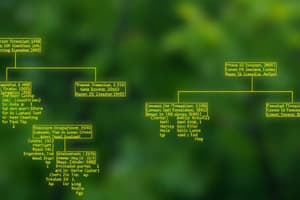Podcast
Questions and Answers
What is the primary goal of the greedy decision tree learning algorithm?
What is the primary goal of the greedy decision tree learning algorithm?
- To reduce the complexity of the decision tree
- To select the best feature to split the data (correct)
- To maximize the accuracy of the predictions
- To minimize the number of features used
What is the problem of selecting the best feature to split the data referred to as?
What is the problem of selecting the best feature to split the data referred to as?
- Problem 2: Stopping Condition
- Problem 1: Feature Selection (correct)
- Problem 4: Data Preprocessing
- Problem 3: Feature Engineering
How is the classification error calculated in a decision tree?
How is the classification error calculated in a decision tree?
- By calculating the ratio of correctly classified instances
- By calculating the proportion of misclassified instances (correct)
- By calculating the difference between the predicted and actual values
- By calculating the number of misclassified instances
What is the purpose of calculating the entropy in a decision tree?
What is the purpose of calculating the entropy in a decision tree?
What is the stopping condition in a decision tree?
What is the stopping condition in a decision tree?
What is the main difference between the greedy decision tree learning algorithm and other decision tree algorithms?
What is the main difference between the greedy decision tree learning algorithm and other decision tree algorithms?
What is the problem of determining when to stop splitting the data referred to as?
What is the problem of determining when to stop splitting the data referred to as?
What is the entropy when all examples are of the same class?
What is the entropy when all examples are of the same class?
What is the purpose of calculating the information gain in a decision tree?
What is the purpose of calculating the information gain in a decision tree?
What is the formula for calculating entropy?
What is the formula for calculating entropy?
What is the information gain in the context of decision trees?
What is the information gain in the context of decision trees?
What is the purpose of the feature split selection algorithm?
What is the purpose of the feature split selection algorithm?
What is the entropy of the example 'ssss'?
What is the entropy of the example 'ssss'?
What is the information gain when splitting on the 'Credit' feature?
What is the information gain when splitting on the 'Credit' feature?
Why is the decision split on the 'Credit' feature?
Why is the decision split on the 'Credit' feature?
What is the entropy of the example 'sf'?
What is the entropy of the example 'sf'?
What is the primary objective when choosing feature h*(x) in decision tree learning?
What is the primary objective when choosing feature h*(x) in decision tree learning?
What is the next step after learning a decision stump?
What is the next step after learning a decision stump?
What is the first stopping condition in decision tree learning?
What is the first stopping condition in decision tree learning?
What is the main characteristic of greedy decision tree learning?
What is the main characteristic of greedy decision tree learning?
What is the final output of the decision tree prediction algorithm?
What is the final output of the decision tree prediction algorithm?
What is the main idea behind tree learning?
What is the main idea behind tree learning?
Flashcards are hidden until you start studying
Study Notes
Decision Trees
- Step-by-step process for greedy decision tree learning:
- Start with an empty tree
- Select a feature to split data
- For each split of the tree, determine whether to make predictions or continue splitting
- Feature selection criteria:
- Entropy and Information Gain
Entropy and Information Gain
- Entropy: measures the impurity of data
- If all examples are of the same class, entropy = 0
- If examples are evenly split between classes, entropy = 1
- Formula: 𝐸𝑛𝑡𝑟𝑜𝑝𝑦 = ∑ - 𝑝𝑖 log 2 𝑝𝑖
- Information Gain: measures the effectiveness of a split
- Formula: Information Gain = Entropy (parent) - (weighted average) Entropy (children)
Calculating Information Gain
- Example 1: Credit feature
- Entropy (parent) = 0.9905
- Entropy (excellent) = 0
- Entropy (fair) = 0.8865
- Entropy (poor) = 0.769
- Information Gain = 0.9905 - (0.225)(0) - (0.325)(0.8865) - (0.45)(0.769) = 0.6599
- Example 2: Term feature
- Entropy (3 years) = 0.72
- Entropy (5 years) = 0.88
- Information Gain = 0.9905 - (0.5)(0.72) - (0.5)(0.88) = 0.1905
- Decision: Split on Credit feature since it has the highest Information Gain (0.6599)
Feature Split Selection Algorithm
- Given a subset of data M (a node in a tree)
- For each feature hi(x):
- Split data of M according to feature hi(x)
- Compute classification error OR Information gain split
- Choose feature h*(x) with lowest classification error or highest Information gain
Recursion and Stopping Conditions
- Tree learning = Recursive stump learning
- Stopping conditions:
- All data agrees on y
- Already split on all features
Prediction Algorithm
- Decision tree prediction algorithm
- Greedy decision tree learning
Studying That Suits You
Use AI to generate personalized quizzes and flashcards to suit your learning preferences.




